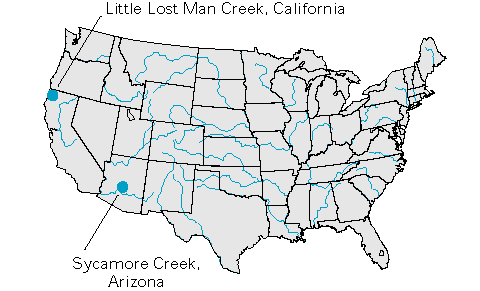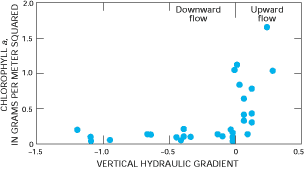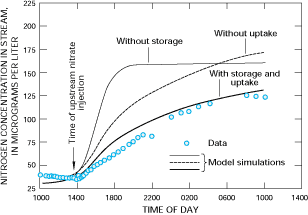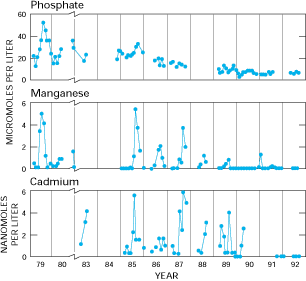F
The Interface Between Ground Water and Surface Water as an Environmental Entity
In the bed and banks of streams, water and solutes can exchange in both directions across the streambed. This process, termed hyporheic exchange, creates subsurface environments that have variable proportions of water from ground water and surface water. Depending on the type of sediment in the streambed and banks, the variability in slope of the streambed, and the hydraulic gradients in the adjacent ground-water system, the hyporheic zone can be as much as several feet in depth and hundreds of feet in width. The dimensions of the hyporheic zone generally increase with increasing width of the stream and permeability of streambed sediments.
The importance of the hyporheic zone was first recognized when higher than expected abundances of aquatic insects were found in sediments where concentrations of oxygen were high. Caused by stream-water input, the high oxygen concentrations in the hyporheic zone make it possible for organisms to live in the pore spaces in the sediments, thereby providing a refuge for those organisms. Also, spawning success of salmon is greater where flow from the stream brings oxygen into contact with eggs that were deposited within the coarse sediment.
 |
The hyporheic zone also can be a source of nutrients and algal cells to streams that foster the recovery of streams following catastrophic storms. For example, in a study of the ecology of Sycamore Creek in Arizona, it was found that the algae that grew in the top few inches of streambed sediment were quickest to recover following storms in areas where water in the sediments moved upward (Figure F-1). These algae recovered rapidly following storms because concentrations of dissolved nitrogen were higher in areas of the streambed where water moved upward than in areas where water moved downward. Areas of streambed where water moved upward are, therefore, likely to be the first areas to return to more normal ecological conditions following flash floods in desert streams.
Hyporheic zones also serve as sites for nutrient uptake. A study of a coastal mountain stream in northern California indicated that transport of dissolved oxygen, dissolved carbon, and dissolved nitrogen in stream water into the hyporheic zone stimulated uptake of nitrogen by microbes and algae attached to sediment. A model simulation of nitrogen uptake (Figure F-2) indicated that both the physical process of water exchange between the stream and the hyporheic zone and the biological uptake of nitrate in the hyporheic zone affected the concentration of dissolved nitrogen in the stream.
The importance of biogeochemical processes that take place at the interface of ground water and surface water in improving water quality for human consumption is shown by the following example. Decreasing metal concentrations (Figure F-3) in drinking-water wells adjacent to the River Glatt in Switzerland was attributed to the interaction of the river with subsurface water. The improvement in ground-water quality started with improved sewage-treatment plants, which lowered phosphate in the river. Lower phosphate concentrations lowered the amount of algal production in the river, which decreased the amount of dissolved organic carbon flowing into the riverbanks. These factors led to a decrease in the bacteria-caused dissolution of manganese and cadmium that were present as coatings on sediment in the aquifer. The result was substantially lower dissolved metal concentrations in ground water adjacent to the river, which resulted in an unexpected improvement in the quality of drinking water.
Figure F-1: Abundance of algae in streambed sediments, as indicated by concentration of chlorophyl a, was markedly greater in areas where water moved upward through the sediments than in areas where water moved downward through the sediments in Sycamore Creek in Arizona. (Modified from Valett, H.M., Fisher, S.G., Grimm, N.B., and Camill, P., 1994, Vertical hydrologic exchange and ecologic stability of a desert stream ecosystem: Ecology, v. 75, p. 548-560.) (Reprinted with permission.)
Figure F-2: Nitrate injected into Little Lost Man Creek in northern California was stored and taken up by algae and microbes in the hyporheic zone. (Modified from Kim, B.K.A., Jackman, A.P., and Triska, F.J., 1992, Modeling biotic uptake by periphyton and transient hyporheic storage of nitrate in a natural stream: Water Resources Research, v. 28, no.10, p. 2743-2752.)
Figure F-3: A decline in manganese and cadmium concentrations after 1990 in drinking-water wells near the River Glatt in Switzerland was attributed to decreased phosphate in the river and hydrologic and biogeochemical interactions between river water and ground water. (Modified from von Gunten, H.R., and Lienert, Ch., 1993, Decreased metal concentrations in ground water caused by controls on phosphate emissions: Nature, v. 364, p. 220-222.) (Reprinted with permission from Nature, Macmillan Magazines Limited.)


